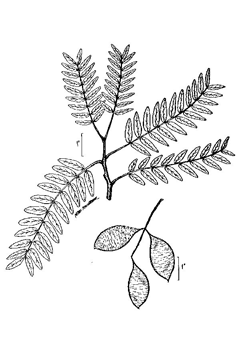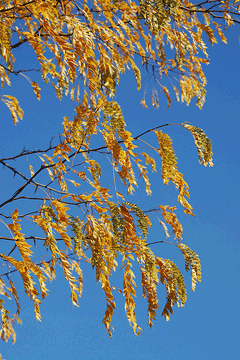 |
|
USDA-NRCS PLANTS Database / USDA NRCS. Wetland flora: Field office illustrated guide to plant species. USDA Natural Resources Conservation Service. |
 |
| http://www.flickr.com/photos/rob-young |
Translate this page:
Summary
Physical Characteristics

 Gleditsia aquatica is a deciduous Tree growing to 12 m (39ft 4in) at a slow rate.
Gleditsia aquatica is a deciduous Tree growing to 12 m (39ft 4in) at a slow rate.
See above for USDA hardiness. It is hardy to UK zone 6. It is in leaf from June to October, in flower from July to August, and the seeds ripen from October to December. The species is hermaphrodite (has both male and female organs) and is pollinated by Insects.
It can fix Nitrogen.
Suitable for: light (sandy), medium (loamy) and heavy (clay) soils. Suitable pH: mildly acid, neutral and basic (mildly alkaline) soils. It cannot grow in the shade. It prefers moist or wet soil. It can tolerate atmospheric pollution.
UK Hardiness Map
US Hardiness Map
Synonyms
Plant Habitats
Woodland Garden Secondary; Sunny Edge; Bog Garden;
Edible Uses
References More on Edible Uses
Medicinal Uses
Plants For A Future can not take any responsibility for any adverse effects from the use of plants. Always seek advice from a professional before using a plant medicinally.
None known
References More on Medicinal Uses
The Bookshop: Edible Plant Books
Our Latest books on Perennial Plants For Food Forests and Permaculture Gardens in paperback or digital formats.

Edible Tropical Plants
Food Forest Plants for Hotter Conditions: 250+ Plants For Tropical Food Forests & Permaculture Gardens.
More

Edible Temperate Plants
Plants for Your Food Forest: 500 Plants for Temperate Food Forests & Permaculture Gardens.
More

More Books
PFAF have eight books available in paperback and digital formats. Browse the shop for more information.
Shop Now
Other Uses
Soil stabilization Wood
Having an extensive root system, it is planted for stabilizing wet banks and marshes[200]. Wood - heavy, very hard, strong, durable in contact with the soil, coarse-grained[82, 229]. It weighs 46lb per cubic foot[235]. The wood is extremely durable and is used primarily for making fence posts[229].
Special Uses
Nitrogen Fixer
References More on Other Uses
Cultivation details
Easily grown in a loamy soil, requiring a sunny position[11]. Succeeds in most soils[200]. Tolerates atmospheric pollution[200]. Rather tender when young, it grows best in S. Britain[11]. A slow-growing tree[11], it is growing well at the Hillier Arboretum in Hampshire where a tree was 7 metres tall and 8 metres wide in 1993[K]. Trees have a light canopy, they come into leaf late in the spring and drop their leaves in early autumn[200] making them an excellent top storey tree in a woodland garden. Plants in this genus are notably resistant to honey fungus[200]. This species has a symbiotic relationship with certain soil bacteria, these bacteria form nodules on the roots and fix atmospheric nitrogen. Some of this nitrogen is utilized by the growing plant but some can also be used by other plants growing nearby[200].
References Carbon Farming Information and Carbon Sequestration Information
Temperature Converter
Type a value in the Celsius field to convert the value to Fahrenheit:
Fahrenheit:
The PFAF Bookshop
Plants For A Future have a number of books available in paperback and digital form. Book titles include Edible Plants, Edible Perennials, Edible Trees,Edible Shrubs, Woodland Gardening, and Temperate Food Forest Plants. Our new book is Food Forest Plants For Hotter Conditions (Tropical and Sub-Tropical).
Shop Now
Plant Propagation
Seed - pre-soak for 24 hours in warm water and then sow in spring in a greenhouse[78]. The seed should have swollen up, in which case it can be sown, if it has not swollen then soak it for another 24 hours in warm water. If this does not work then file away some of the seed coat but be careful not to damage the embryo[78]. Further soaking should then cause the seed to swell. One it has swollen, the seed should germinate within 2 - 4 weeks at 20°c. As soon as they are large enough to handle, prick the seedlings out into individual deep pots and plant them out into their permanent positions in the summer. Give the plants some protection from the cold for their first few winters outdoors.
Other Names
If available other names are mentioned here
Native Range
NORTHERN AMERICA: United States (Indiana (south), Illinois (south), Missouri, Alabama, Arkansas, Florida (north & central), Georgia, Louisiana, Mississippi, South Carolina, Texas)
Weed Potential
Right plant wrong place. We are currently updating this section.
Please note that a plant may be invasive in one area but may not in your area so it's worth checking.
Conservation Status
IUCN Red List of Threatened Plants Status :

Growth: S = slow M = medium F = fast. Soil: L = light (sandy) M = medium H = heavy (clay). pH: A = acid N = neutral B = basic (alkaline). Shade: F = full shade S = semi-shade N = no shade. Moisture: D = dry M = Moist We = wet Wa = water.
Now available:
Food Forest Plants for Mediterranean Conditions
350+ Perennial Plants For Mediterranean and Drier Food Forests and Permaculture Gardens.
[Paperback and eBook]
This is the third in Plants For A Future's series of plant guides for food forests tailored to
specific climate zones. Following volumes on temperate and tropical ecosystems, this book focuses
on species suited to Mediterranean conditions—regions with hot, dry summers and cool, wet winters,
often facing the added challenge of climate change.
Read More
Expert comment
Author
Marshall.
Botanical References
1182200
Links / References
For a list of references used on this page please go here
Readers comment
| Add a comment |
|
If you have important information about this plant that may help other users please add a comment or link below. Only comments or links that are felt to be directly relevant to a plant will be included. If you think a comment/link or information contained on this page is inaccurate or misleading we would welcome your feedback at [email protected]. If you have questions about a plant please use the Forum on this website as we do not have the resources to answer questions ourselves.
* Please note: the comments by website users are not necessarily those held by PFAF and may give misleading or inaccurate information.
To leave a comment please Register or login here All comments need to be approved so will not appear immediately.
|
Subject : Gleditsia aquatica
|
|
|
|